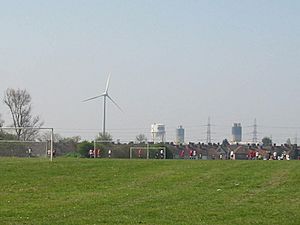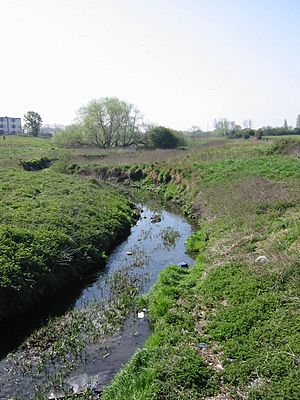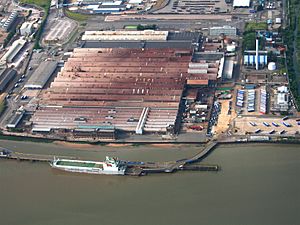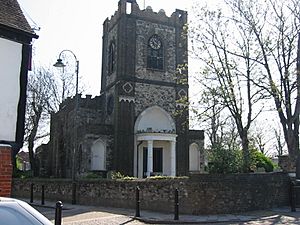Dagenham facts for kids
Quick facts for kids Dagenham |
|
|---|---|
 The southern Dagenham skyline includes structures of the Ford plant and wind turbines. |
|
| Population | 106,247 (2011) |
| OS grid reference | TQ485845 |
| • Charing Cross | 11.5 mi (18.5 km) W |
| London borough | |
| Ceremonial county | Greater London |
| Region | |
| Country | England |
| Sovereign state | United Kingdom |
| Post town | DAGENHAM |
| Postcode district | RM8-RM10 |
| Post town | BARKING |
| Postcode district | IG11 |
| Dialling code | 020 |
| Police | Metropolitan |
| Fire | London |
| Ambulance | London |
| EU Parliament | London |
| UK Parliament |
|
| London Assembly | |
Dagenham is a town in East London, England. It is part of the London Borough of Barking and Dagenham. Dagenham is located about 11.5 miles (18.5 km) east of Charing Cross in central London.
Historically, Dagenham was a quiet countryside area in Essex. It stretched from Hainault Forest in the north to the River Thames in the south. For a long time, Dagenham remained mostly undeveloped. This changed in 1921. The London County Council started building a huge housing area called the Becontree estate.
Many people moved to Dagenham in the early 20th century. Because of this growth, Dagenham became an Urban District in 1926. It then became a Municipal Borough in 1938. In 1965, Dagenham joined Greater London. Most of its historic area became part of the London Borough of Barking and Dagenham.
Dagenham became a key place for factories and businesses. It is very famous for the Ford Dagenham car plant. This is where the important Ford sewing machinists strike of 1968 happened. After many factories closed, the southern part of Dagenham near the River Thames is now being redeveloped. This area is called London Riverside. A new area called Beam Park is being built where the old Ford Dagenham site used to be.
Contents
History of Dagenham
| Year | People |
|---|---|
| 1881 | 3,411 |
| 1891 | 4,324 |
| 1901 | 6,091 |
| 1911 | 7,930 |
| 1921 | 9,127 |
| 1931 | 89,362 |
| 1941 | # |
| 1951 | 114,568 |
| 1961 | 108,368 |
| # No census was held in 1941 due to World War II. | |
| Source: UK census | |
What's in a Name?
The name Dagenham first appeared in a document from 666 AD. It was written as Dæccanhaam. This name likely came from a small farm. "Ham" meant farm or home in Old English. So, Dæccan hamm meant "home of a man called Dæcca."
Factories and Jobs
In 1931, the Ford Motor Company moved its car plant to Dagenham. It became Europe's largest car factory. The site was huge, covering 500 acres (2 square km). It even had its own blast furnaces and power station. This allowed Ford to import raw materials and export finished cars.
At its busiest, the Dagenham plant had 4 million square feet of space. It employed 40,000 people. In 2002, Ford stopped making cars there. This was because it was hard to update the old factory. Also, other Ford sites in Europe were newer.
Today, the Dagenham plant focuses on making diesel engines. It produces half of Ford's diesel engines worldwide. About 4,000 people still work at the Ford plant. You can also see the Dagenham wind turbines there.
The movie Made in Dagenham (2010) tells the story of the 1968 Ford sewing machinists strike. Women workers at the plant stopped working. They were protesting against unfair treatment and unequal pay.
Other important companies were also in Dagenham. Sterling Ltd made weapons for the British Army. Ever Ready made batteries. Bergers Paint and the chemical company May and Baker were also here. May and Baker made a new antibiotic called M&B 693 in 1935. The May & Baker plant closed in 2013. The site is now being redeveloped with new shops.
How Dagenham was Governed
Dagenham was an old parish in Essex. A parish is like a small local area. From 1894, it was part of the Romford Rural District.
As London grew, Dagenham's local government changed. In 1926, Dagenham became an urban district. This meant it had its own local council. In 1938, it became a municipal borough. This gave it even more power to manage its own affairs.
In 1965, the Municipal Borough of Dagenham was ended. Its area became part of the London Borough of Barking and Dagenham. This is how Dagenham became part of Greater London.
From Farms to Homes
In 1205, Dagenham was big enough to have a chaplain. The Parish Church of St Peter and St Paul was probably built around this time.
In 1854, the first railway line came through Dagenham. It was near the River Thames. Later, in 1885, a new railway station called Dagenham opened.
Dagenham was still a small village until the 1920s. That's when the London County Council started building the huge Becontree estate. This massive housing project also spread into nearby areas like Ilford and Barking. It caused a very fast increase in Dagenham's population.
In 1932, the District line of the London Underground was extended to Upminster. New tube stations opened in Dagenham. These were called Dagenham (now Dagenham East) and Heathway (now Dagenham Heathway).
How Dagenham is Run Today
Dagenham is divided into different areas called wards. These wards are part of two main areas for the UK Parliament. These are the Dagenham and Rainham Parliamentary Constituency and the Barking Parliamentary Constituency.
Each ward elects local councillors. These councillors represent the people on the Barking and Dagenham London Borough Council. The whole area is also part of the City and East London Assembly Constituency.
Where is Dagenham?

Dagenham is about 11.5 miles (18.5 km) east of central London. A large part of Dagenham is inside the Becontree estate. But Dagenham also includes other areas. These are Becontree Heath, part of Rush Green, the old Dagenham village, and the southern part near Dagenham Dock and the River Thames.
The southern part, which includes the Ford Dagenham site, is part of a big redevelopment project. This project is called London Riverside and is part of the Thames Gateway. The Dagenham post town covers the entire Becontree estate. This includes parts that were built in Barking and Ilford.
People of Dagenham
Dagenham is known as a working-class area. In the 2000s, many people from other countries moved to Dagenham, especially from Africa.
The 2011 census showed the different groups of people living in Dagenham. For example, in the Alibon ward, 61% of people were White British. 15% were Black African. Other wards had similar mixes of people.
What's Made in Dagenham Now?
The old May and Baker factory site in Dagenham East is now a busy place for making films and television shows.
Getting Around Dagenham
Dagenham has good transport links. You can use the London Underground (the Tube) from three stations: Becontree, Dagenham East, and Dagenham Heathway. All these stations are on the District line.
You can also catch trains from Dagenham Dock station. These services are run by c2c. The Elizabeth Line also runs from nearby Chadwell Heath station.
There are also many London Buses routes that serve Dagenham. These include routes 145, 173, 174, 175, 287, 364, EL1, and EL2. Some routes, like 128 and EL1, run 24 hours a day.
Culture and Fun
Valence House is in Becontree Avenue. It is the only one of Dagenham's old manor houses that is still standing. It dates back to the 13th century and has a moat around part of it. Valence House is the local history museum for Barking and Dagenham. It shows items and old records that tell the story of the people who lived there.
The museum also has a special collection from the Fanshawe family. They lived at Parsloes Manor, which is now gone. This collection is very important.
The Roundhouse pub was a famous rock music venue between 1969 and 1975. Many famous bands played there. These included Jethro Tull, Supertramp, Queen, Pink Floyd, Eric Clapton, Status Quo, and Led Zeppelin.
Local News
The Barking & Dagenham Post is a local newspaper. It is printed every week and also available online.
Sports in Dagenham
Dagenham & Redbridge F.C. is the local football team. They play at Victoria Road. They have played in different professional leagues.
Motorcycle speedway races used to happen at the greyhound stadium in Ripple Road in the 1930s. A team called the Dagenham Daggers took part in local competitions.
Dagenham's main cricket club is Goresbrook Cricket Club. They won the Essex County Cricket League in 2011.
Dagenham has a park called King George's Field. It was renamed in 1953 by Queen Elizabeth II to honor King George V. There are also other parks like Valence and Parsloes.
The Dagenham Crusaders Drum and Bugle Corps was the first British Drum Corps. They performed in the United States in 1983.
Famous People from Dagenham
Many well-known people have connections to Dagenham:
- Actress Adelayo Adedayo grew up in Dagenham.
- Football legend Alf Ramsey, who managed England to win the World Cup, was born here in 1920.
- George Carey, a former archbishop of Canterbury, was once the vicar at St Peter and St Paul's Church.
- Musician and comedian Dudley Moore grew up in Dagenham.
- 1960s pop singer Sandie Shaw, who won the Eurovision Song Contest in 1967, was born in Dagenham.
- Arsenal and England footballer Tony Adams grew up in Dagenham.
- Rap artist Devlin grew up in Dagenham.
- Australian singer John Farnham was born in Dagenham.
- Darts player Wayne Mardle was born in Dagenham.
- Singer and TV presenter Stacey Solomon is from Dagenham.
- Singer Steve Ignorant from the band Crass grew up in Dagenham.
- Actor Richard Wisker was born in Dagenham.
- Blues singer Chris Youlden was born in Dagenham.
See also
 In Spanish: Dagenham para niños
In Spanish: Dagenham para niños




